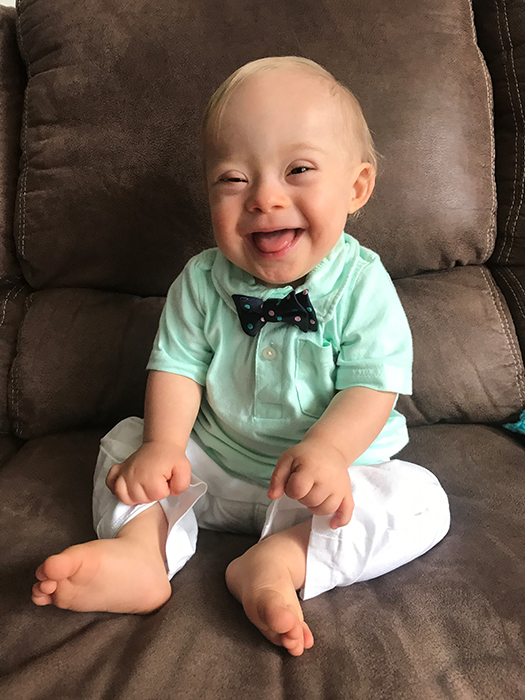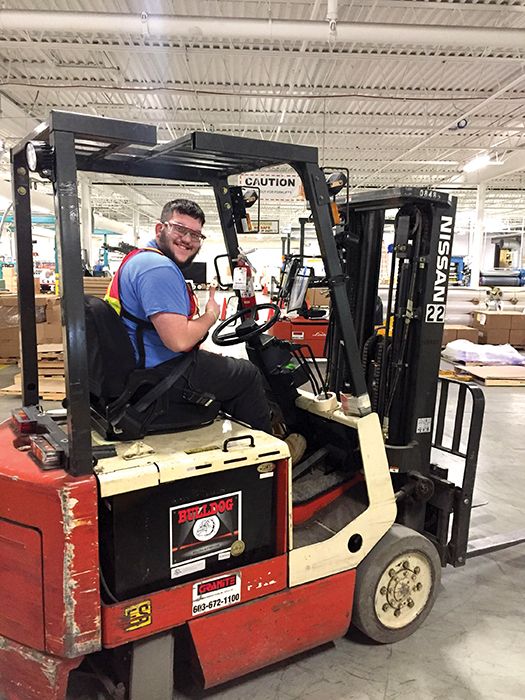Every weekday morning before dawn, John Richard’s wife drops him off at Market Basket in Nashua. He begins his custodial shift on the empty plaza hours before the cashiers set up their registers. As he has for the last 33 years, he collects the trash around the parking lot, vacuums any litter on the ground and organizes the carriages.
As the day lumbers forward, he assists an elderly customer or two to the car, bags groceries and stocks the restrooms with supplies. By 3 p.m., he checks out. By Friday, he’s worked 40 hours.
Richard is legally blind. He belongs to a minority in NH but not because of his visual impairment. Richard works full-time, and yet among Americans with disabilities between the ages of 18 and 64, only 35.9 percent work some type of job, compared to 76.6 percent for people without disabilities, according to the 2017 Disability Statistics Annual Report from UNH.
This leaves a 40-point employment gap, on par with NH.
This is not because of a lack of motivation. On the contrary, says Lauren Applebaum of RespectAbility, a D.C.-based organization that promotes opportunities for individuals with disabilities and fights stigma. Despite a civil rights law that protects people with disabilities from discrimination in the workplace, Applebaum says individuals with disabilities struggle to get hired.
Multiple surveys prove that while, in 1990, the Americans with Disabilities Act (ADA) changed regulations, it didn’t change perceptions. Applebaum cites a 2011 Cornell hospitality study that showed that employers didn’t think individuals with disabilities could finish assigned tasks. And researchers from Rutgers University responded to more than 6,000 advertised positions by sending fictional cover letters, two-thirds of which revealed either a spinal cord injury or the presence of Asperger’s. The “applicants” with disabilities received 26 percent fewer responses than those without.
Frustration with employers rejecting his own applications led Forrest Beaudoin-Friede of Temple, a 22-year-old with Down syndrome, to launch a gluten-free bakery with his younger brother.
New Opportunity
Unemployment in NH is dipping to around 3 percent. The result is that employers are scrambling to find applicants. New data from the Institute on Disability at the University of NH reveals that job growth, nationwide, for people with disabilities jumped four fold between 2015 and 2016. In December of 2016, 343,483 more people with disabilities joined the American workforce compared to only 87,201 in December of the previous year.
In NH, according to data from RespectAbility and the U.S. Department of Labor’s Office of Disability Employment Policy, 1,355 more people with disabilities in NH gained employment between 2015 and 2016, a 3.7 percent increase. According to those stats, there are 36,745 people with disabilities between the ages of 18 and 64 employed in the state. That’s 41.7 percent of working age people with disabilities, versus 82.8 percent of working age people without disabilities who are employed in the state.
Tracey Frye is not surprised at the rising numbers. She’s been with the state Department of Education’s vocational rehabilitation office since 2009 and can’t remember when the activity was this high.
One reason for the uptick is that people with disabilities face less stigma, says Lisa Hinson-Hatz, who directs the state’s vocational rehabilitation office. Efforts to reduce negative stereotypes begin early on in schools, where teachers integrate students of all abilities, ensuring students respect and become familiar with each other. Younger generations, nurtured in integrated academic settings, are more at ease with co-workers who are disabled than their older counterparts.
Hinson-Hatz mentions that media plays a role, too, as actors like Micah Fowler, who has cerebral palsy, stars on ABC’s Speechless, and Meredith Eaton, on ABC’s McGyver, has dwarfism. Advertising has jumped into the advocacy fray, as Gerber Products Company selected its first baby with Down syndrome as its 2018 poster child.

ABC's "Speechless" star Micah Fowler. Courtesy of ABC/Bob D'Amico

Lucas, Gerber's 2018 poster child. Courtesy photo.
The Economics
But economists are less likely to credit the altruism of ad agencies and other media for the uptick in employment for individuals with disabilities. Researchers like Andrew Houtenville, associate professor of economics and research director of the Institute on Disability at UNH, perceive the growth through the lens of supply and demand: “In times of low unemployment,” he says, “businesses reach out to populations they traditionally didn’t reach out to before.”
And while some may argue that hiring people with intellectual and developmental disabilities (IDD) showcases an inclusive attitude that appeals to a wider swath of prospective employees, companies need to do more than promote integrity to remain profitable. They must also reduce costs and improve efficiency.
Promoting a tangible benefits analysis to corporations is the mission of nonprofits like the PLUS (People Learning Useful Skills) Company in Nashua, which helps people with IDD find jobs. Maggie Hinkle, the director of career and business services, says employers are still recovering from the 2008 recession, and when they laid people off, many high-level workers took over lower-level tasks. With the aid of a job coach, a person with IDD offsets existing employees’ workloads, allowing skilled laborers to focus on other critical activities.

PLUS Company client Josh Kyrias, a shipping/receiving associate at Worthen Industries, trains on the forklift. Courtesy photo.
Hinkle is careful to point out that hiring a worker who is disabled is not a charitable gesture; it’s good for the bottom line. Take Worthen Industries in Nashua, for example. It makes adhesive tape used for nail guns, among other products. On the production floor, a machine operator cuts tape into pancake-like discs; a second operator helps with the product coming out of the machine. Plant Manager Jim Dodos hired, in July 2017, a PLUS Company client as its third person to package and palletize the newly cut products in boxes, freeing up more skilled workers.
A representative from the PLUS Company will visit an operation, such as a manufacturing floor, and look for routine assignments. Then they match a client’s skill sets with the position. Recruiting a person with disabilities, who is motivated and enthusiastic, curbs the high turnover rate usually associated with entry-level positions, says Hinkle. “People with developmental disabilities thrive on routine and carry with them a sense of pride that’s contagious.”
Economic Disparities
Yet for all the progress made in the labor force for people with disabilities, the likelihood of employment in NH pales sharply in contrast to those without a disability.
In NH, between 11 and 12.5 percent of the population live with a disability, according to the 2017 Disability Statistics Annual Report from UNH. Those between the ages of 21 and 64 who receive developmental services from The Area Agency System earn on average, $8.54 per hour, compared to an average $24.69 for non-disabled individuals, according to the most recent NH Developmental Services Employment Data report.
Most of the individuals work part-time while 8.2 percent work 30 to 40 hours per week and 1 percent work more than 40 hours. These disparities show no sign of narrowing. Individuals with disabilities remain underestimated and underemployed, says Applebaum of RespectAbility. She says the perception of people with disabilities as “inspiring” perpetuates low expectations. She cites an example of an employer claiming that if a person in a wheelchair can complete a task that means anyone can do it.
“That [comment] doesn’t help people with disabilities,” says Applebaum, “in any way, shape or form. We all want to be held to the same standards.”
She hears from students about professors bestowing higher grades than they deserve because they feel badly for them. On the face of it, this may seem like an act of kindness. Yet the expression does nothing more than reinforce the stigma that people with disabilities aren’t capable, she says.
In 2008, the Americans with Disabilities Act (ADA) Amendments Act widened the criteria for people with disabilities, helping to protect more people from unfair labor practices. But it also heightened concerns among employers about the financial impact of accommodations.
To be sure, some types of assistive technologies are pricey. But more than half cost nothing, while the typical one-time expenditure is $500, according to research from the Job Accommodation Network.
As Hinkle reminds bosses, employers make accommodations for non-disabled employees, too, as when they rearrange hours, allow employees to work from home or take time off to care for sick family members.
Safety Net vs. Holding Back
The social security disability insurance (SSDI) program provides a safety net for the most vulnerable: those whose medical conditions limit their functions of daily living. Nonetheless, some argue the program’s current design provides a disincentive to work.
John Connelly directs research for the Council of State Administrators for Vocational Rehabilitation (CSAVR). His organization wants individuals applying for SSDI to receive counseling quickly so they can evaluate work alternatives while waiting for benefits. It also favors a more gradual reduction in cash benefits as work and earnings increase.
As Connelly explains, anyone who’s tried to apply for SSDI knows it’s not easy to get, and the wait can take months or years.
When they finally get it, they’re afraid if they earn beyond a certain threshold, they’ll lose it. Connelly argues that by eliminating the current all-or-nothing paradigm, people are more likely to reenter the workforce.
So far, legislators and aides have “politely listened” to the CSAVR proposal, says Connelly, but it hasn’t caught any tailwind.
Demographic Changes
One of the fastest growing segments of NH’s population is seniors and the likelihood of a disability increases with age.
Lastly, older Americans are not leaving the workforce as they reach retirement age. They are working and living longer than previous generations. A little more than one-third of NH’s disabled population is over 65. Some with congenital conditions like Down syndrome are surviving later in life because of medical advancements; others are developing impairments related to aging, such as loss of hearing or mobility.
Despite the growing strain these developments place on vocational agencies that service those with disabilities, hope is on the horizon. New Hampshire’s seniors are shattering myths of what it means to age, as they launch startups, pursue flexible hours in traditional organizations and serve as role models to younger employees. It is this over-65 faction that may alter the narrative for working people of all abilities and ages.

 Current Issue - April 2024
Current Issue - April 2024